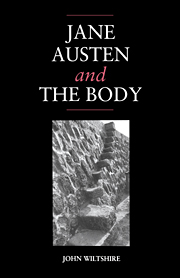Book contents
- Frontmatter
- Contents
- Acknowledgements
- A note on texts
- Introduction: Jane Austen and the body
- 1 Sense, sensibility and the proofs of affection
- 2 ‘Eloquent blood’: the coming out of Fanny Price
- 3 Emma: the picture of health
- 4 Persuasion: the pathology of everyday life
- 5 Sanditon: the enjoyments of invalidism
- Notes
- Bibliography
- Index
4 - Persuasion: the pathology of everyday life
Published online by Cambridge University Press: 11 November 2009
- Frontmatter
- Contents
- Acknowledgements
- A note on texts
- Introduction: Jane Austen and the body
- 1 Sense, sensibility and the proofs of affection
- 2 ‘Eloquent blood’: the coming out of Fanny Price
- 3 Emma: the picture of health
- 4 Persuasion: the pathology of everyday life
- 5 Sanditon: the enjoyments of invalidism
- Notes
- Bibliography
- Index
Summary
That future of confinement to an unvarying, limited neighbourhood, supported with the spirits only of ruined happiness, sighted for a moment by Emma Woodhouse from the Hartfield windows on a miserable evening in July, becomes the actual condition of the gradually disclosed heroine of Persuasion, Austen's last completed novel. If Emma is a picture of health, the first volume of Persuasion, one can say with only a small exaggeration, is a portrait of suffering. Anne Elliot is a woman oppressed and insignificant, a ‘nobody’, discouraged by a burden of grief and regret that she has borne alone for the seven years prior to the novel's inception.
Her attachment and regrets had, for a long time, clouded every enjoyment of youth; and an early loss of bloom and spirits had been their lasting effect … No second attachment, the only thoroughly natural, happy, and sufficient cure, at her time of life, had been possible to the nice tone of her mind, the fastidiousness of her taste, in the small limits of the society around them. (28)
Having been persuaded to break off an engagement with a man whom she still loves, she wears her sadness and deprivation in her prematurely aging body and face. ‘A few years before, Anne Elliot had been a very pretty girl, but her bloom had vanished early’, now ‘faded and thin’, ‘her spirits were not high’, as her only friend Lady Russell admits, and this lack of resilience and of energy is evidenced in her first act in the novel, her intervention to persuade her sister Elizabeth about the ambitions of the hanger-on, Mrs Clay. Elizabeth arrogantly repudiates her advice, as she has foreseen.
- Type
- Chapter
- Information
- Jane Austen and the Body'The Picture of Health', pp. 155 - 196Publisher: Cambridge University PressPrint publication year: 1992



